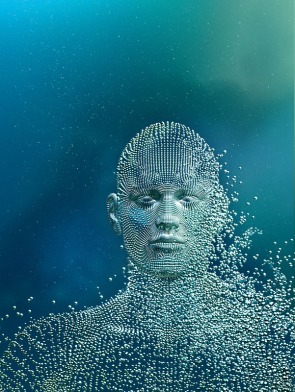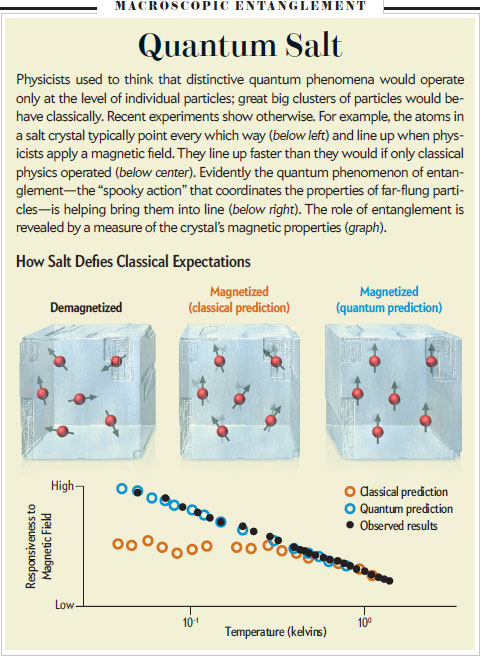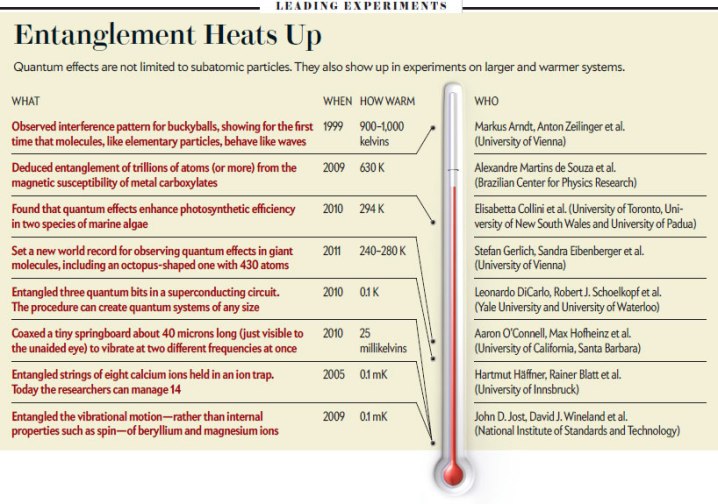The following excerpts are from an article in the June 2011 Scientific American magazine, titled “Living In a Quantum World,” written by physicist and Oxford professor of physics, Vlatko Vedral. All emphasis is mine.
 According to standard physics textbooks, Quantum mechanics is the theory of the microscopic world. It describes particles, atoms, and molecules but gives way to ordinary classical physics on the macroscopic scales of pears, people, and planets. Somewhere between molecules and pears lies a boundary where the strangeness of quantum behavior ends and the familiarity of classical physics begins…
According to standard physics textbooks, Quantum mechanics is the theory of the microscopic world. It describes particles, atoms, and molecules but gives way to ordinary classical physics on the macroscopic scales of pears, people, and planets. Somewhere between molecules and pears lies a boundary where the strangeness of quantum behavior ends and the familiarity of classical physics begins…
[T]his convenient partitioning of the world is a myth. Few modern physicists think that classical physics has equal status with quantum mechanics; it is but a useful approximation of a world that is quantum at all scales. Although quantum effects may be harder to see in the macroworld, the reason has nothing to do with size per se but with the way that quantum systems interact with one another. Until the past decade, experimentalists had not confirmed that quantum behavior persists on a macroscopic scale. Today, however, they routinely do. These effects are more pervasive than anyone ever suspected. They may even operate in the cells of our body…
In the modern point of view, the world looks classical because the complex interactions that an object has with its surroundings conspire to conceal quantum effects from our view… Larger things tend to be more susceptible to decoherence than smaller ones, which justifies why physicists can usually get away with regarding quantum mechanics as a theory of the microworld…
[In the world of physics,] Entanglement binds together individual particles into an indivisible whole. A classical system is always divisible, at least in principle; whatever collective properties it has arises from components that themselves have certain properties. But entangled systems cannot be broken down this way. Entanglement has strange properties. Even when the entangled particles are far apart, they still behave as a single entity, leading to what Einstein famously called “spooky action at a distance.”
Most demonstrations of entanglement involve at most a handful of particles. Larger batches are harder to isolate from their surroundings. The particles in them are likelier to become entangled with stray particles, obscuring their original interconnections. In accordance with the language of decoherence, too much information leaks out into the environment, causing the system to behave classically….
 A neat experiment in 2003 proved that larger systems, too, can remain entangled when the leakage is reduced or somehow counteracted. Gabriel Aeppli of University College London and his colleagues took a piece of lithium fluoride salt and put it in an external magnetic field. You can think of the atoms in the salt as little spinning magnets that try to align themselves with the external field, a response known as magnetic susceptibility. Forces that the atoms exert on one another act as a kind of peer pressure to bring them into line more quickly . As the researchers varied the strength of the magnetic field, they measured how quickly the atoms became aligned. They found that they atoms responded much faster than the strength of their mutual interactions would suggest. Evidently some additional effect was helping the atoms to act in unison, and the researchers argued that entanglement was the culprit. If so, the 1020 atoms of the salt form a hugely entangled state.
A neat experiment in 2003 proved that larger systems, too, can remain entangled when the leakage is reduced or somehow counteracted. Gabriel Aeppli of University College London and his colleagues took a piece of lithium fluoride salt and put it in an external magnetic field. You can think of the atoms in the salt as little spinning magnets that try to align themselves with the external field, a response known as magnetic susceptibility. Forces that the atoms exert on one another act as a kind of peer pressure to bring them into line more quickly . As the researchers varied the strength of the magnetic field, they measured how quickly the atoms became aligned. They found that they atoms responded much faster than the strength of their mutual interactions would suggest. Evidently some additional effect was helping the atoms to act in unison, and the researchers argued that entanglement was the culprit. If so, the 1020 atoms of the salt form a hugely entangled state.
To avoid confounding the effects of the random motions associated with heat energy, Aeppli’s team did its experiments at extremely low temperatures- a few millikelvins. Since then, however, Alexandre Martins de Souza of the Brazilian Center for Physics research in Rio de Janeiro and his colleagues have discovered macroscopic entanglement in materials such as copper carboxylate at room temperature and higher. In these systems, the interaction among particles spins is strong enough to resist thermal chaos… Physicists have seen entanglement in systems of increasing size and temperature, from ions trapped by electromagnetic fields to ultra-cold atoms in lattices to superconducting quantum bits…
Other experiments scale up this basic idea, so that huge numbers of atoms become entangled and enter states that classical physics would deem impossible. And if solids can be entangled when they are large and warm, it takes only a small leap of imagination to ask whether the same might be true of a very special kind of large, warm system: life…

People have long wondered whether birds and other animals might have some built-in compass. In the 1970’s the husband wife team of Wolfgang and Roswitha Wiltschko of the University of Frankfurt in Germany caught robins that had been migrating to Africa and put them in artificial magnetic fields. Oddly, the robins, they found, were oblivious to the reversal of the magnetic field direction, indicating that they could not tell north from south. The birds did, however, respond to the inclination of the earth’s magnetic field- that is, the angle that the field lines make with the surface. That is all they need to navigate. Interestingly, blindfolded robins did not respond to a magnetic field at all, indicating that they somehow sense the field with their eyes.
In 2000 Thorsten Ritz, a physicist then at the University of Southern Florida who has a passion for migratory birds, and his colleagues proposed that entanglement is the key. In their Scenario, which builds on the previous work of Klaus Schulten of the University of Illinois, a bird’s eye has a type of molecule in which two electrons form an entangled pair with zero total spin. Such a situation simply cannot be mimicked with classical physics. When this molecule absorbs visible light, the electrons get enough energy to separate and become susceptible to external influences, including the earths magnetic field. If the magnetic field is inclined, it affects the two electrons differently, creating an imbalance that changes the chemical reaction that the molecule undergoes. Chemical pathways in the eye translate this difference into neurological impulses, ultimately creating an image of the magnetic field in the bird’s brain…
Another biological process where entanglement may operate is photosynthesis, the process whereby plants convert sunlight into chemical energy. Incident light ejects electrons inside plant cells, and these electrons all need to find their way to the same place: the chemical reaction center where they can deposit their energy and set off the reactions that fuel plant cells. Classical physics fails to explain the near-perfect efficiency with which they do so…
The division between the quantum and classical worlds appears not to be fundamental. It is just a question of experimental ingenuity, and few physicists now think that classical physics will ever really make a comeback at any scale. If anything, the general belief is that if a deeper theory ever supersedes quantum physics, it will show the world to be even more counterintuitive that anything we have so far…